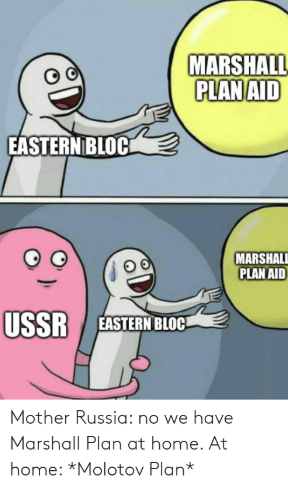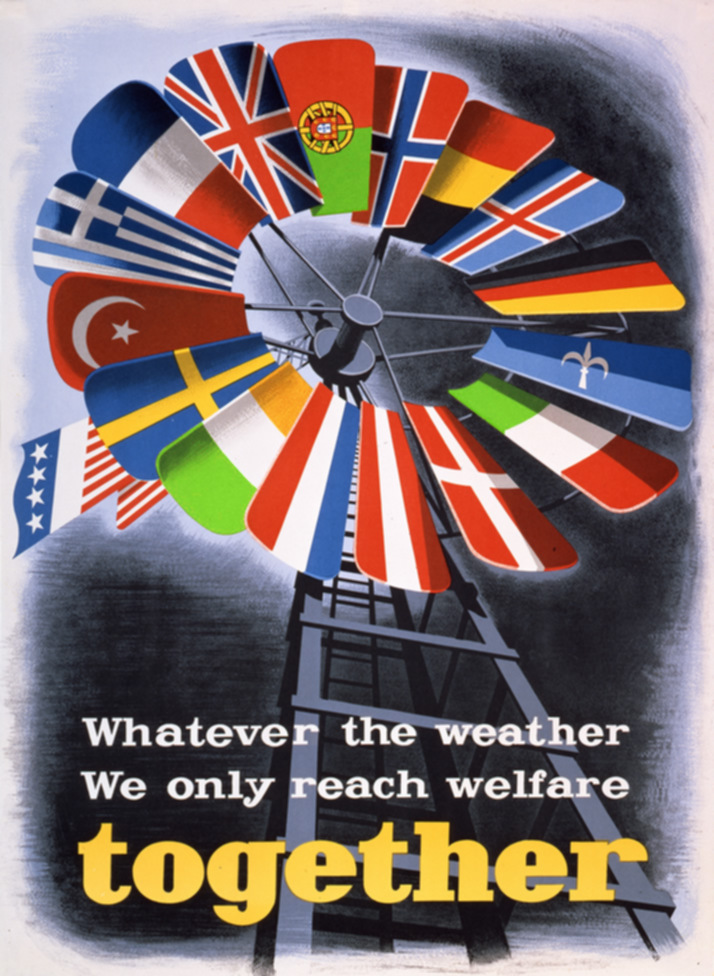
9.2 Rebuilding Europe After World War II
2 min read•january 14, 2023
Sharii Liang
Isabela Padilha Vilela
Sharii Liang
Isabela Padilha Vilela
Practically in ruins due to WWII, Europe was struggling to recover. Entire economies were crippled, not just for the losers of the war. Only two countries could provide the aid needed to recover. The results of their differing economic aid policies would set a precedent for what was to come later on during the .
The U.S is Here to Help!
Partially worried about the rise of communism in Europe and the economic status of Europe, the US proposed the . Approved by Congress, America offered $13 billion in aid to all of Europe on the sole condition that they work together for mutual benefit.
The money loaned by America stimulated the reconstruction and massive economic growth of a torn post-war Europe. Considered an “economic miracle” and highlighting the importance of in the modern world (Western and , as well as America), the West flourished immensely. America got the trade it desired from Europe AND Central and got the funds they need to rebuild themselves! Win-win, right?

The was one of the most notable strategies, as it not only helped to recover and stabilize European economies, it strengthened the ties in the Western world. The policy, however, furthered the division of Europe because only western nations were recipients of this massive U.S benefit. Eastern nations, such as the governments of , , , , became under the influence of the , and were excluded from the .
Keep That Money to Yourself
The USSR was not pleased with the US’s involvement in European affairs, to say the least. Most of , under the influence and control of the USSR (), refused the aid of the United States. This denial of aid would cause further tension between the two countries.
As an alternative, the came up with the in 1947. All nations under the influence of the USSR or allied with them were offered financial aid. It resembled the but only for . This policy did not bring about the same success that the did, and would lag far, farther behind Western and as a result.
This would be the first of many ideological conflicts, economic and political, between the two nations.
The scoreboard? Capitalism: 1. Communism: 0.

Key Terms to Review (15)
Bulgaria
: A country located in southeastern Europe, known for its diverse terrain encompassing Black Sea coastline, rivers, and mountainous areas. It has a rich heritage dating back to ancient civilizations like the Thracians, Romans, Byzantines and Bulgars.Central Europe
: Central Europe is a region located in the middle of the European continent, typically including countries like Germany, Poland, Czech Republic, Austria, Slovakia, Hungary and Switzerland.Cold War
: The Cold War was a period of political and military tension between the United States and its allies (the West) and the Soviet Union and its satellite states (the East) from 1947 to 1991. It was characterized by threats, propaganda, and other measures short of open warfare.Communist Nations
: These are countries where the government exercises control over the economy and society based on communist principles. The state owns all property and means of production, and there is no private enterprise.Consumerism
: Consumerism is a social and economic order that encourages the acquisition of goods and services in ever-increasing amounts.Czechoslovakia
: Czechoslovakia was a sovereign state in Central Europe that existed from October 1918, when it declared its independence from the Austro-Hungarian Empire, until its peaceful dissolution into the Czech Republic and Slovakia on January 1, 1993.Eastern Europe
: Eastern Europe generally encompasses countries east of Germany and Austria including Russia, Ukraine, Poland among others. Historically these nations were less economically developed compared to Western Europe.Hungary
: Hungary is a landlocked country in Central Europe known for its rich history dating back to the Roman Empire. It was part of the Eastern Bloc during the Cold War era.Marshall Plan
: The Marshall Plan, officially known as the European Recovery Program, was an American initiative passed in 1948 to aid Western Europe. It provided over $12 billion (nearly $100 billion in 2020 US dollars) in economic assistance to help rebuild Western European economies after the end of World War II.Molotov Plan
: The Molotov Plan was an economic aid program initiated by the Soviet Union in 1947 for its satellite nations in Eastern Europe after World War II, similar to the Marshall Plan offered by the United States to Western Europe.Poland
: Poland is a country located in Central Europe known for its rich history which includes periods of great prosperity interspersed with devastating invasions.Romania
: A southeastern European country known for its forested region of Transylvania and preserved medieval towns. It has had a complex history with influences from different empires throughout centuries.Satellite Nations
: Satellite nations were countries that were under heavy political, economic, and military influence or control from another country. During Cold War, this term was used primarily to refer to Central and Eastern European countries under USSR's influence.Soviet Union
: The Soviet Union was a federal socialist state that existed from 1922 to 1991. It was a one-party state governed by the Communist Party with Moscow as its capital in its largest republic, Russian SFSR.Western Europe
: Western Europe is the region comprising the western part of Europe. Countries within this region are known for their high standard of living, democratic political structures, and strong economies. During the Cold War, it was associated with capitalist democracies under the influence of the United States.9.2 Rebuilding Europe After World War II
2 min read•january 14, 2023
Sharii Liang
Isabela Padilha Vilela
Sharii Liang
Isabela Padilha Vilela
Practically in ruins due to WWII, Europe was struggling to recover. Entire economies were crippled, not just for the losers of the war. Only two countries could provide the aid needed to recover. The results of their differing economic aid policies would set a precedent for what was to come later on during the .
The U.S is Here to Help!
Partially worried about the rise of communism in Europe and the economic status of Europe, the US proposed the . Approved by Congress, America offered $13 billion in aid to all of Europe on the sole condition that they work together for mutual benefit.
The money loaned by America stimulated the reconstruction and massive economic growth of a torn post-war Europe. Considered an “economic miracle” and highlighting the importance of in the modern world (Western and , as well as America), the West flourished immensely. America got the trade it desired from Europe AND Central and got the funds they need to rebuild themselves! Win-win, right?

The was one of the most notable strategies, as it not only helped to recover and stabilize European economies, it strengthened the ties in the Western world. The policy, however, furthered the division of Europe because only western nations were recipients of this massive U.S benefit. Eastern nations, such as the governments of , , , , became under the influence of the , and were excluded from the .
Keep That Money to Yourself
The USSR was not pleased with the US’s involvement in European affairs, to say the least. Most of , under the influence and control of the USSR (), refused the aid of the United States. This denial of aid would cause further tension between the two countries.
As an alternative, the came up with the in 1947. All nations under the influence of the USSR or allied with them were offered financial aid. It resembled the but only for . This policy did not bring about the same success that the did, and would lag far, farther behind Western and as a result.
This would be the first of many ideological conflicts, economic and political, between the two nations.
The scoreboard? Capitalism: 1. Communism: 0.

Key Terms to Review (15)
Bulgaria
: A country located in southeastern Europe, known for its diverse terrain encompassing Black Sea coastline, rivers, and mountainous areas. It has a rich heritage dating back to ancient civilizations like the Thracians, Romans, Byzantines and Bulgars.Central Europe
: Central Europe is a region located in the middle of the European continent, typically including countries like Germany, Poland, Czech Republic, Austria, Slovakia, Hungary and Switzerland.Cold War
: The Cold War was a period of political and military tension between the United States and its allies (the West) and the Soviet Union and its satellite states (the East) from 1947 to 1991. It was characterized by threats, propaganda, and other measures short of open warfare.Communist Nations
: These are countries where the government exercises control over the economy and society based on communist principles. The state owns all property and means of production, and there is no private enterprise.Consumerism
: Consumerism is a social and economic order that encourages the acquisition of goods and services in ever-increasing amounts.Czechoslovakia
: Czechoslovakia was a sovereign state in Central Europe that existed from October 1918, when it declared its independence from the Austro-Hungarian Empire, until its peaceful dissolution into the Czech Republic and Slovakia on January 1, 1993.Eastern Europe
: Eastern Europe generally encompasses countries east of Germany and Austria including Russia, Ukraine, Poland among others. Historically these nations were less economically developed compared to Western Europe.Hungary
: Hungary is a landlocked country in Central Europe known for its rich history dating back to the Roman Empire. It was part of the Eastern Bloc during the Cold War era.Marshall Plan
: The Marshall Plan, officially known as the European Recovery Program, was an American initiative passed in 1948 to aid Western Europe. It provided over $12 billion (nearly $100 billion in 2020 US dollars) in economic assistance to help rebuild Western European economies after the end of World War II.Molotov Plan
: The Molotov Plan was an economic aid program initiated by the Soviet Union in 1947 for its satellite nations in Eastern Europe after World War II, similar to the Marshall Plan offered by the United States to Western Europe.Poland
: Poland is a country located in Central Europe known for its rich history which includes periods of great prosperity interspersed with devastating invasions.Romania
: A southeastern European country known for its forested region of Transylvania and preserved medieval towns. It has had a complex history with influences from different empires throughout centuries.Satellite Nations
: Satellite nations were countries that were under heavy political, economic, and military influence or control from another country. During Cold War, this term was used primarily to refer to Central and Eastern European countries under USSR's influence.Soviet Union
: The Soviet Union was a federal socialist state that existed from 1922 to 1991. It was a one-party state governed by the Communist Party with Moscow as its capital in its largest republic, Russian SFSR.Western Europe
: Western Europe is the region comprising the western part of Europe. Countries within this region are known for their high standard of living, democratic political structures, and strong economies. During the Cold War, it was associated with capitalist democracies under the influence of the United States.
Resources
© 2024 Fiveable Inc. All rights reserved.
AP® and SAT® are trademarks registered by the College Board, which is not affiliated with, and does not endorse this website.